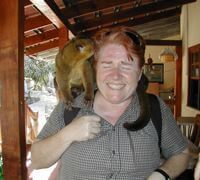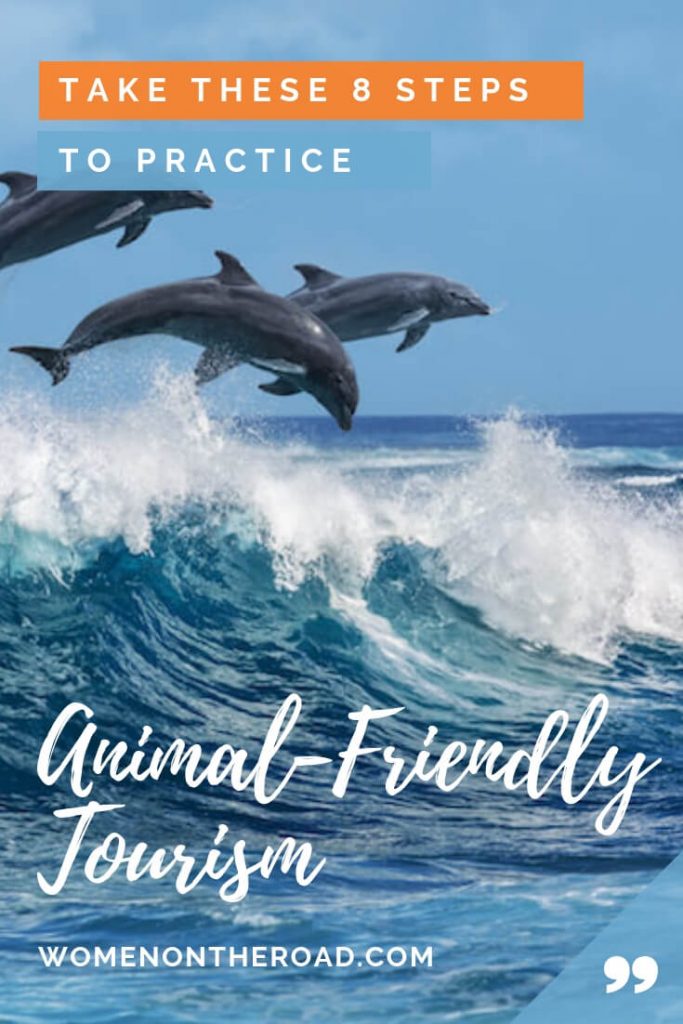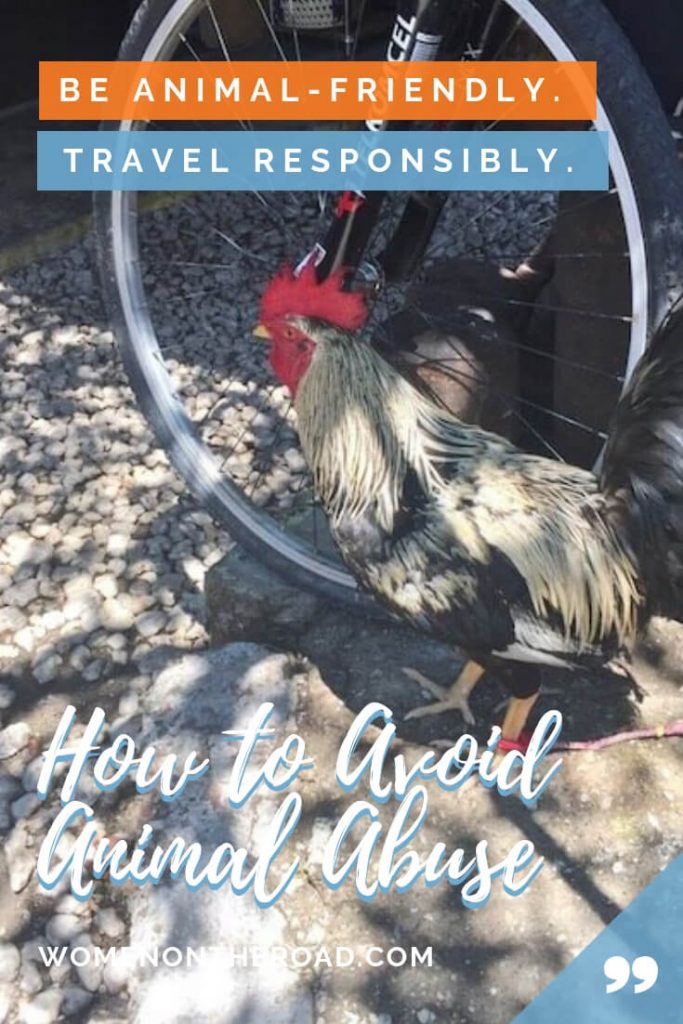Most of us wouldn’t dream of harming an animal, at home or in our travels.
Given a chance, we’ll always opt for animal-friendly tourism.
When we do take part in activities that involve animals, isn’t it because we love them and want to be near them?
The irony is that sometimes we don’t understand the impact of our animal tourism activities. We simply don’t know animals have been hurt to bring us pleasure.
Getting up close and personal with wildlife isn’t necessarily what it seems.
“Millions of animals are harmed in varying degrees through tourism,” said Chris Pitt of Right Tourism, an organization that helps make your travels animal-friendly. “Yet there are many ways to enjoy wildlife and animals when you travel without harming any of them.”
Animal cruelty Can Take Many Forms
Of course, I’m aware of the obvious – snakes with their fangs removed and mouths sewn up or monkeys chained and trained to perform or elephants trained to carry tourists. Yet some activities that seem innocuous can hurt animals.
Such as taking a simple photograph.
Like this one of a kincajou peeing on my shoulder. Was this photograph acceptable? I’m not sure.

This animal was rescued rather than captured so I thought it would be all right. What I didn’t think about was whether this might stress the animal… Today, I would ask so many more questions.
Let’s take the gibbon, a type of monkey, as another example. If someone suggests you pose for a picture with a captive gibbon, would you ask yourself how it got there? Gibbon families don’t easily let go of their young so the family was probably killed, the gibbon baby declawed and its teeth taken out (probably not humanely). If feisty or aggressive, the baby would be reined in brutally until obedient. It would then be kept in a small cage, used for long days, possibly drugged.
So… next time you see a gibbon – or any tame animal usually found in the wild – ask yourself how it got there.
Another example: the lion cub
Often a cub will be drugged and asleep to be approachable. That animal may have been kidnapped from the wild, its family murdered. Once the cub grows up, what happens to it? It can’t be released into the wild because it has spent its life in captivity. In some countries, the adult lion may become a victim of canned hunting – where people pay to hunt. Hunting a human-friendly animal in an enclosed place is not an experience any compassionate person would relish.

“In one case in Thailand exposed by Care for the Wild, people were allowed to pet tigers. These were marketed as rescued tigers, lovingly tamed so tourists could photograph them,” said Chris Pitt.
“Yet no tiger was ever released into the wild so it wasn’t a conservation operation but purely a breeding and petting zoo. The tigers lived in small concrete cages, subdued, chained… yet people who visited did so because they loved animals – they were harming the thing they loved.”
ANIMAL ABUSE IN TOURISM: THEY AREN’T HERE TO ENTERTAIN US!
Elephant trekking or taking an elephant ride in Thailand is incredibly popular.
It may look like fun and part of an ‘authentic adventure’ in some Asian (and increasingly African) countries but beware. These elephants are brutally trained to obey: their spirit is crushed in youth, and they are physically abused with bullhooks, spiked sticks, and other weapons designed to subdue them, all as part of a domination game humans inevitably win.

Think you’ve researched your elephant sanctuary visit enough? Think again.
Take it from someone who thought they had only to find out that there was a whole lot more going on than they wanted you to know.
Elephant tourism is a growing industry and, as such, there are a lot of ruthless practices that may be taking place either behind the scenes or even in broad daylight. Taking the time to get some in-depth information about where you are going and how the animals are treated could be the difference between ongoing cruelty or a change in attitudes and better protection for these gentle, human-like mammals.
Elephant riding and sanctuaries that chain animals and attempt to control them using bullhooks and fear are still far too prevalent. Spending a little time to research where you want to go and ask probing questions will help weed out those who are still making money off the misery of animals and ultimately eliminate such practices.
That way we all have a better chance of witnessing the true beauty and spirit of an elephant.
– by Christina Petrides of Working on the Road
Trekking isn’t only about elephants.
Camels in the desert, for example, can easily be mistreated by being denied sufficient food or water, or sometimes being overloaded with two people. I recently took a trek into the Sahara Desert in Morocco and had no idea at that time that I should be looking for a number of things: general healthy appearance, strong walk, personality, the owner’s treatment…
Fortunately my camel seemed healthy and its owner treated it with great kindness and respect. If he hadn’t, however, I might not have known how to deal with it. Now I do.
It’s not always about riding, either. Animals can be made to pull exceedingly heavy weights or raised to fight – dogfights, cockfights and bullfights are some of the more common examples.


I remember writing a story about the Arabian oryx many years ago when I worked with WWF International (aka World Wildlife Fund). Tourists would rent 4×4 vehicles and stampede across the desert to chase this rare and beautiful animal, wearing it down until, exhausted, it would collapse – and often die. How fun.
Even the friendliest animals can be harmed by well-meaning humans.
When a dozen or more boats converge to watch dolphins, this may scare them away. Dolphins gather around feeding grounds so when you see a school of them, you’re probably watching them close to where they eat. Being surrounded by boats can cause them stress and prevent them from proper feeding.

According to Pitt, there are best practice guidelines for ethical animal tourism, for example, how heavily loaded with tourist bags an animal should be, or how and how often tourist boats should approach whales or dolphins. Tourism professionals need to know what they’re doing before they work with animals, and we need to express our concern in a way it will be heard.
HOW DO YOU MAKE SURE AN ACTIVITY IS ANIMAL-FRIENDLY?
- Think. Ask yourself questions. Does it feel right? Why is this animal here? Beware of anything that brings you into contact with captive animals. Don’t take anything at face value.
- Does the animal look healthy and well looked after?
- What about the organizers? Does the tour company or operator think in terms of conservation and sustainability? Check out their websites: if they’re behaving well, they’ll be vocal about it.
- Is the animal stressed? Just because a dolphin looks as though it’s smiling doesn’t mean it’s happy. A slow loris may go all floppy and cute when it’s tickled but it is petrified.
- What if the culture allows it? We all want to be culturally sensitive but plenty of animal cruelty is inflicted under the guise of tradition, such as bullfighting in Spain or cockfighting in Thailand. Would you condone that at home? Just because it’s someone’s tradition doesn’t make it right – consider avoiding traditions that harm animals. I grew up in Spain where bullfighting was common – I didn’t realize how cruel it was until I began researching these issues.
8 STEPS TO ENVIRONMENTALLY RESPONSIBLE TOURISM
The good news is that we are not powerless when it comes to nature and wildlife tourism. There are things we can do to enjoy animals in our travels while making sure they aren’t harmed.
- Do plenty of research before you go. Right Tourism has country pages that can alert you to what is going on at your destination. YouTube has many animal cruelty videos – just watch one to understand what is going on. Watching more might break your heart.
- Choose experiences that don’t harm animals, such as a reputable research zoo or conservation project rather than a shoddy operator bent only on commercial gain. Research zoos can be wonderful places that initiate us to that first contact with animals and influence us for the rest of our lives. If you think an animal is being harmed by an activity – stay away.
- Ask questions before you book. If interaction with wildlife is involved in an activity, find out how this is possible. Is the animal drugged? Has it been ‘altered’ in any way – declawed or defanged, for example? When in doubt, stay away. If a quick and convincing answer isn’t forthcoming, don’t take a chance.
- When viewing wildlife, keep your distance. Stay on the tracks. Don’t try to befriend wildlife or get close in any way. If your guide stays away and respects the animals, tip him or her generously. Some guides think that by taking you closer (even if they know it’s wrong) they’re pleasing you. Show your displeasure.
- Respect wildlife habitat. Many animals today are endangered not because of hunting (that too) but because their habitat has been degraded or destroyed by overtourism, carelessness or the spread of infrastructure like roads or airports. This robs wildlife of room to move around or things to eat. There’s a great saying for this: “Take only photos, leave only footprints.” But – as you saw above – even photos must be thought through.
- Don’t try to rescue stray animals – give money to a local rescue charity instead. If the animals look in any way harmed or sad, contact the tourist board or tour company and tell them this is not acceptable and that you won’t return unless something is done. Tourist dollars have a loud voice in many countries and complaints have succeeded in eliminating certain harmful activities and even changing laws.
- Rethink what you do and how you behave. I stopped eating commercial chicken when I found out about the way battery hens are treated and I’m now trying to mend my ways on other food fronts. I’m not there yet but each day, the question of an animal’s wellbeing is more present in my mind. I’m now thinking about these things far more often than I used to.
- Take a stand. Speak out. Just because something is acceptable in some countries doesn’t necessarily make it right. No, don’t put yourself in the line of danger – there are many ways you can speak out that don’t involve confrontation. Deal with the tourist board, the tour operator, or snap a photo of the mistreatment and post it on social media. Sometimes an image will speak louder than words.
And of course, don’t buy souvenirs made of animal products…
As Chris says, “When you travel, don’t leave your brain and your morals at home.”

ON A FINAL NOTE…
Animals aren’t only inhumanely trained or used – they are often killed for body parts.
Sadly, illegal wildlife trafficking is on the rise, endangering some iconic species and driving them to the edge of extinction. Poaching in Africa alone costs the continent US$25 million in lost tourist dollars.
Ivory’s street value can fetch more than US$ 2000/kg (1 kilogram is 2.2 lbs) in Beijing while black market rhino horn can sell for upward of US$ 66,000/kg in China – more than gold or platinum! The immense value of this trade – in the billions of dollars – is fuelling an unprecedented expansion.
To do something about it conservationists have developed a smartphone app that allows people to report sightings of suspicious sales: snap a photo with the app (without putting yourself in danger, please!) and it is automatically uploaded to conservation authorities who track these things.
It’s not THE solution, but all intelligence helps!
In the end, awareness and education are the bulwarks against animal cruelty in tourism. The more we know, the less we accept, the louder we voice our concerns.
If we stop paying for animal-centric activities, we will be wiping out demand.
— Originally published on 05 September 2014
PIN THESE PICTURES AND SAVE FOR LATER!



